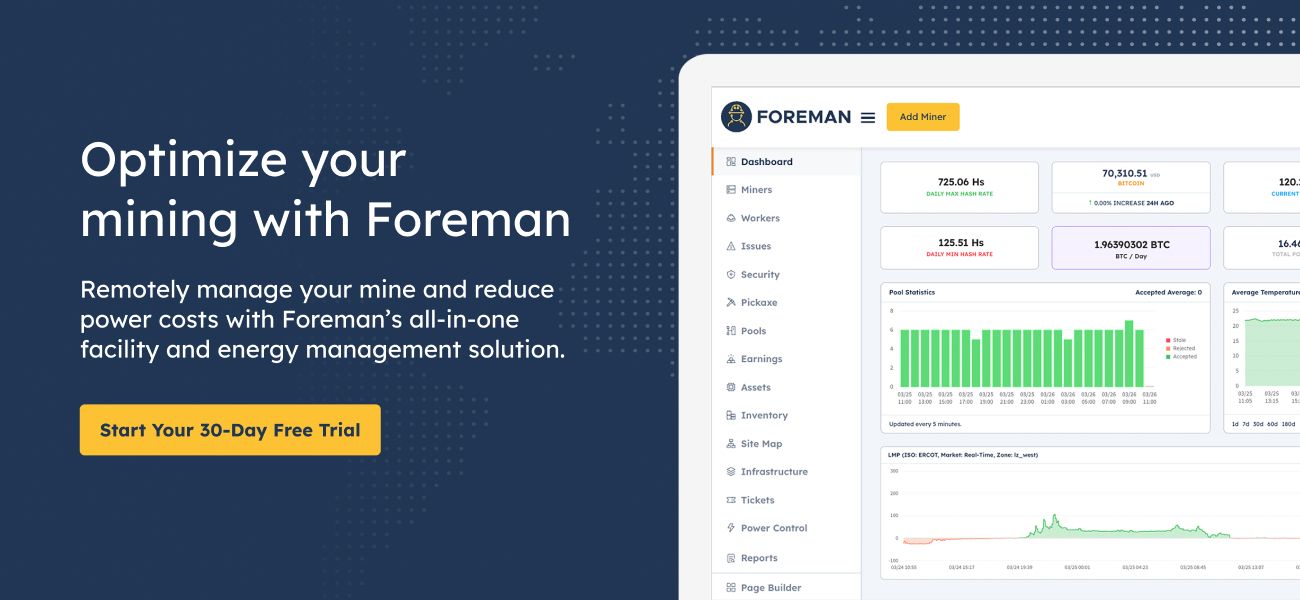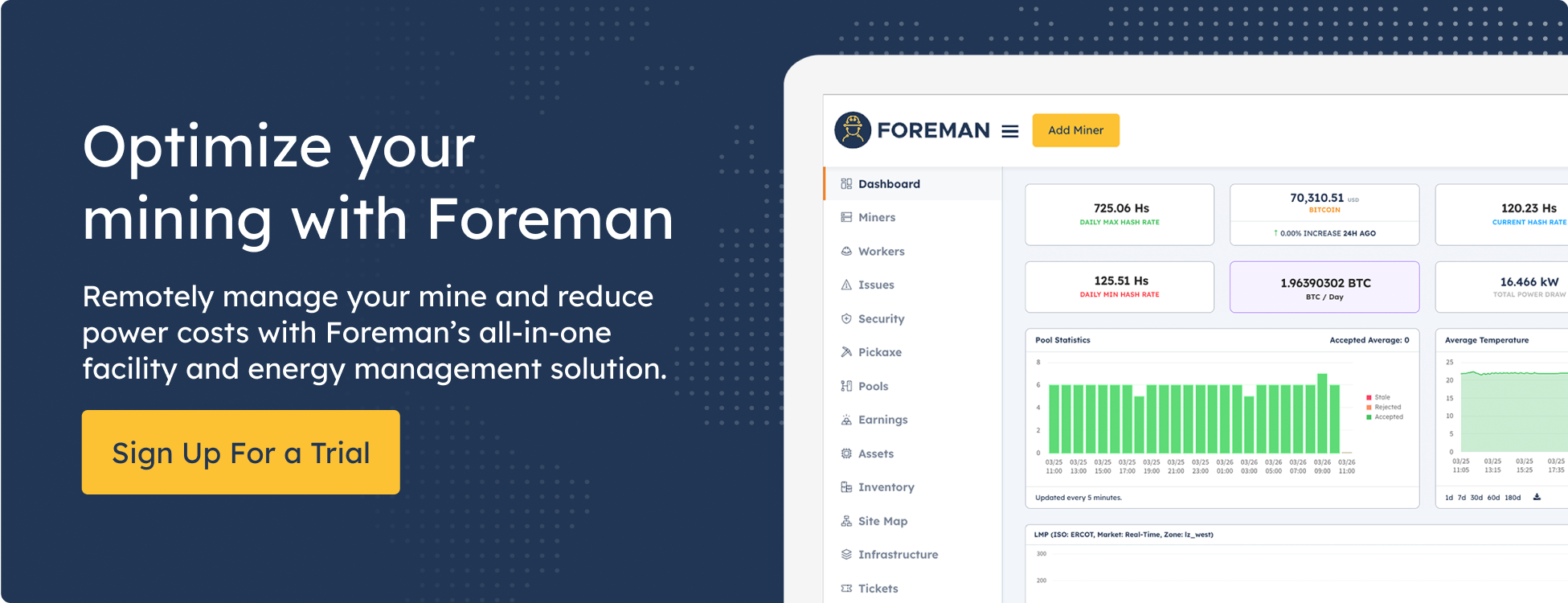To succeed in the Bitcoin Mining industry, you need the right equipment and infrastructure to handle the high computational demands of mining. In this article, we'll explore the essential equipment required for Bitcoin mining and provide recommendations for selecting the best products available. Whether new to Bitcoin mining or a seasoned professional, this guide will help you make informed decisions and optimize your mining operations.
Below you will find the following:
- Summary of the different areas of a Bitcoin mine
- List of equipment
- What to look for in specific equipment
- Tips and tricks to know when building a facility
This article primarily references large site facilities and equipment. For insights regarding Bitcoin mining containers, check out our article here.
ASICs
- Understand ROI
- Cost of ASIC vs. hashrate and J/TH
- Historical revenue per kWh
Choosing the right ASIC miner is critical to the success of your Bitcoin mining operation. When selecting an ASIC miner, you should consider several factors, such as the hash rate, power consumption, purchase timing, ROI, and cost.
Cost is another essential factor to consider, as ASIC miners can be expensive, and you'll need to factor in the ROI (Return on Investment) and other associated costs to determine the profitability of your mining operation. Some miners say when purchasing equipment, there should be an ROI of around 12 months for each machine.
One of the most significant drawbacks is the high cost of buying new miners. New machines can be expensive, and you may need to invest substantial capital to purchase the necessary equipment to start your mining operation. Furthermore, purchasing new machines may also come with the risk of encountering technical issues or defects, resulting in downtime and lost profits.
As new machines hit the market, the efficiency or J/TH of the average machine will move up and start to price out older machines. The other factor to consider is the price of Bitcoin and the bull run. Bitcoin runs in cycles, so purchasing when there is blood in the streets is a good idea, although it can be risky to do so right before the halving when your revenue will get cut in half.
During bull runs, most revenue is produced because the difficulty has not caught up to the price increase, and miners lag bull runs. The demand for machines that produce revenue increases as revenue increases, and the machines' price follows. It is good to plan out in 4-year increments as the Bitcoin halving plays a big role in the price and price of machines.
ASICs & Manufacturers
Below is a list of popular Bitcoin ASIC miners from various manufacturers, showcasing their energy efficiency measured in joules per terahash (J/TH). These values are essential when comparing the performance and cost-effectiveness of different mining hardware. It's important to consider both the capital expenditure (CapEx) – the initial cost of purchasing the miner – and the operational expenditure (OpEx) – the ongoing electricity costs – when assessing the overall profitability of a mining operation. Remember that the values presented are approximate and may vary slightly depending on the miner version or operating conditions. The landscape of ASIC mining is continually evolving, with new and more efficient models released regularly.
Bitmain: A leading Bitcoin hardware manufacturer, Bitmain is well-known for its Antminer series of ASIC miners for their performance and widespread use in the mining community.
MicroBT: A significant competitor to Bitmain, MicroBT produces the Whatsminer series of ASIC miners, which have gained popularity for their efficiency and competitive performance.
Canaan Creative: As one of the pioneers in developing Bitcoin mining hardware, Canaan Creative is known for its AvalonMiner series of ASIC miners, offering a range of options for different mining requirements.
Ebang: A Chinese manufacturer, Ebang produces the Ebit series of ASIC miners, offering various models with different performance levels and price points.
Innosilicon: A popular mining hardware manufacturer, Innosilicon produces ASIC miners for different cryptocurrencies, including the T2 and T3 series specifically designed for Bitcoin mining.
Miner Management and Facility Software
Foreman
Miner management software helps you coordinate your ASICs at scale. It combines site maps, ticketing, remote management, and machine optimization all in one platform to help large-scale mines get the most out of their machines and facility. On top of that, the software has the ability for miners to participate in Demand Response, automating the most cost-effective feature.
Foreman is the platform that helps site managers, partners, and C-levels leverage management technology to propel every aspect of their business. Visit our blog post on Faicilty & Miner Management for a deeper understanding if you'd like to learn more.
Power Monitoring and Management Systems
Incorporating power monitoring and management systems helps track power usage, efficiency, and overall performance of the electrical infrastructure. These systems provide real-time data and alerts, enabling facility managers to optimize energy consumption and address potential issues before they escalate.
External Power Infrastructure
- Transformers and voltage regulation
- Main distribution panels and switchgear
- Uninterruptible power supply systems
- Automatic transfer switches
- Electrical cabling, conduits, and connectors
- Power monitoring and management systems
Specific equipment and components are crucial for a reliable and efficient power supply when building out the electrical infrastructure for a large-scale data center or Bitcoin mining facility. Transformers play a vital role in adjusting voltage levels between the utility power supply and the facility's internal power distribution system, ensuring the voltage is suitable for the mining equipment while improving energy efficiency.
Main distribution panels and switchgear manage the incoming power supply from the utility grid, distributing it throughout the facility. They contain essential components such as circuit breakers, switches, and protective relays that control and protect the electrical system. Uninterruptible power supply systems, on the other hand, provide backup power in case of power outages or fluctuations in the main power supply, maintaining continuous and stable power to the mining equipment and preventing potential downtime or damage.
Automatic transfer switches monitor the primary power source and automatically switch to backup power when the main supply is interrupted or unstable. Transfer switches ensure a continuous power supply to the mining equipment. High-quality electrical cabling, conduits, and connectors are necessary for safe and efficient power transmission throughout the facility. Choosing suitable cable types, sizes, and installation methods is crucial for optimal performance and reducing potential hazards.
A Power Distribution Unit (PDU) differs from the PSUs described above. PDUs distribute power to multiple devices or components, such as ASIC miners, servers, switches, and other networking equipment. When choosing a PDU, it's essential to consider its power rating and ability to prevent the overloading of electrical circuits. Overloading can occur when a PDU supplies more power than the electrical circuit can handle, which can cause damage to the devices and increase the risk of electrical hazards. Choosing a PDU with circuit breakers that can automatically shut off the power when an overload is detected is essential to prevent overloading.
Additionally, some PDUs have remote monitoring and control features, which allow administrators to monitor power usage, track power consumption, and control power distribution remotely. These features can be advantageous in large mining farms where multiple PDUs distribute power to numerous devices. If you want a deeper dive into PDUs, check out our article explaining everything you need to know.
Cooling System, Filtration, and Airflow
- Air conditioning units
- Fans
- Liquid cooling systems
- Temperature monitors
- Mechanical filters (such as air filters, screens, or meshes)
- Other filtration methods (such as electrostatic, UV-C, activated carbon, or HEPA)
The cooling system is a crucial component of a Bitcoin mining farm's infrastructure as it helps regulate the temperature of the mining hardware, prevents overheating, and ensures optimal performance. ASIC miners used for Bitcoin mining generate a significant amount of heat during operation, and if the temperature is not regulated, it can damage the hardware and decrease mining efficiency.
The system typically includes a combination of air conditioning, ventilation, and fans that work together to maintain a stable temperature within the mining farm. The air conditioning system cools the ambient temperature within the room, while the ventilation system helps circulate the cool air and remove hot air from the room. Fans placed near the mining equipment blow cool air directly onto the ASIC miners to help regulate their temperature.
In addition to traditional cooling methods, liquid cooling systems are becoming more popular in Bitcoin mining farms. Liquid cooling involves circulating liquid coolant through the ASIC miners to dissipate heat more efficiently. Liquid cooling can help achieve a more stable and consistent temperature, resulting in higher mining efficiency and lower energy consumption.
Maintaining the cooling system is critical to the success of a Bitcoin mining farm. It's essential to monitor the temperature of the mining equipment regularly, clean the fans and ventilation system regularly to remove dust and debris that can clog the system, and ensure that the air conditioning system is functioning correctly.
Direct Evaporative Cooling
There is a cooling technology called Direct Evaporative Cooling (DEC), a type of evaporative cooling that uses water to cool the air. In DEC, hot air from the mining equipment is passed through a wet filter that cools the air as the water evaporates, reducing the temperature within the mining farm.
DEC can be an effective and energy-efficient cooling solution for Bitcoin mining farms, particularly in dry climates. However, it is less effective in areas with high humidity than in air saturated with moisture, making it easier for water to evaporate and cool the air.
Filtration
In a Bitcoin mining farm, filtration maintains a clean and healthy environment for employees. It prevents dust accumulation and other particles that can clog the mining equipment and reduce efficiency.
The primary type of filtration used in Bitcoin mining is mechanical filtration. Mechanical filtration involves using physical barriers such as air filters, screens, or meshes to remove particles from the air. Mechanical filters are commonly used in Bitcoin mining farms and effectively remove dust and other large particles from the air. Different types of filtration methods, such as electrostatic filtration, UV-C filtration, activated carbon filtration, and HEPA filtration, may also be used depending on the specific needs and circumstances of the mining farm. However, mechanical filtration is the most commonly used method in Bitcoin mining due to its effectiveness and cost efficiency.
Airflow
Facilities use different airflow mechanisms to regulate temperature and maintain a stable environment. Downflow distribution supplies cool air from the ceiling and discharges it at floor level. This mechanism is commonly used in server rooms and data centers. Upflow air distribution, on the other hand, supplies cool air from the floor and discharges it at the ceiling. It is typically used in smaller facilities, such as telecom equipment rooms.
Horizontal airflow supplies cool air through the front of the equipment and discharges hot air from the back of the equipment. This airflow mechanism is commonly used in rack-mounted equipment. Containment airflow, on the other hand, uses barriers or enclosures to contain hot and cold air separately. This mechanism can increase cooling efficiency and reduce energy costs.
Chimney airflow involves using a chimney to discharge hot air from the top of the room. This mechanism is commonly used in facilities with high ceilings. Mixed airflow combines the above mechanisms to create a customized solution based on the facility's needs. This mechanism can help optimize cooling efficiency and reduce energy consumption.
Choosing the proper airflow mechanism depends on various factors, such as the size of the facility, the type of equipment used, and the cooling requirements. By selecting the proper airflow mechanism, facilities can optimize cooling efficiency, reduce energy consumption, and extend the life of the equipment. Proper airflow management can also help prevent equipment failure due to overheating and reduce maintenance costs.
Networking Equipment & Internet Connection
- Switches
- Routers
- Ethernet cables
- Power over Ethernet (PoE) injectors
- Network monitoring tools
The most critical parts for setting up networking equipment in a Bitcoin mining farm include switches, routers, and Ethernet cables. Switches are necessary to connect multiple devices and create a local area network. In contrast, routers connect the mining farm to the internet and provide security features such as firewalls and VPNs. Ethernet cables are used to connect devices to the switches and routers, and it's crucial to use high-quality cables to ensure reliable and stable connectivity.
While PoE injectors, network monitoring tools, and redundant power supplies are essential components, switches, routers, and Ethernet cables are considered the most critical networking equipment in a Bitcoin mining farm. These basic components are necessary to establish a stable and reliable network, which can impact mining efficiency and productivity.
Internet speed and connection reliability are critical components for networking equipment in a Bitcoin mining farm. High-speed internet is necessary for transmitting large amounts of data quickly and efficiently, which is essential for mining cryptocurrencies.
Connection reliability is also crucial, as interruptions or downtime can lead to lost mining opportunities, reduced productivity, and potential data loss. It's essential to use a reliable internet service provider (ISP) with high uptime and low latency to ensure stable and reliable connectivity.
Additionally, implementing backup internet connections or failover mechanisms can provide redundancy and prevent downtime in case of an internet outage.
Having redundancy with internet connections is recommended for Bitcoin mining farms to ensure stable and reliable connectivity, minimize downtime, and maximize mining efficiency and profitability. Redundancy provides backup internet connections or failover mechanisms that can automatically switch to a backup connection in case of an outage or other issues with the primary connection. Load balancing may also be implemented to optimize performance, but it requires careful planning and configuration to avoid potential problems with network congestion.
Server Rack
A server rack typically consists of a metal frame with shelves or slots for mounting servers and other equipment. These racks are available in different sizes and configurations to accommodate various miner types. The need for server racks in a Bitcoin mining farm lies in their ability to provide several benefits, such as organization and space-saving. Server racks help to organize equipment neatly and efficiently, making it easier to access and maintain the equipment. By storing equipment compact and organized, server racks help save space in the mining farm. This can be especially important in larger mining farms where space is limited.
Many Bitcoin miners use our rack curtains to maintain airflow and heat control. Rack curtains are insulating materials placed over the front and rear of a server rack to block airflow and create a more controlled cooling environment. Using rack curtains, you can create a sealed environment within the rack that prevents hot air from escaping and helps regulate temperature more efficiently.
Using rack curtains can be especially important in larger mining farms where multiple racks are close to each other, and hot air from one rack can affect the temperature of surrounding racks. However, it's important to monitor temperature and ensure that the cooling systems within the rack are adequate to prevent equipment from overheating, as rack curtains can increase the risk of equipment failure if misused.
Security
- Physical security
- Network Security
- Staff member Security
- Disaster plan recovery
- Legal and regulatory requirements
Securing a Bitcoin mining farm involves addressing various potential vulnerabilities and threats to ensure the investment's safety and the mining process's uninterrupted operation. Safeguarding the mining farm's location is essential to protect valuable hardware and infrastructure. Implementing access control systems, security cameras, and alarm systems and employing security personnel can provide multiple layers of protection. Check out our article for further instructions on physical security in Container Mining.
Network security is another crucial aspect, requiring firewalls, VPNs, intrusion detection systems, and strong, unique passwords to defend against cyberattacks and unauthorized access. Segregating the mining network from other networks can also help limit potential attack vectors.
It is vital to ensure staff members know security best practices and their roles in maintaining a secure environment. Regular training and updates on cybersecurity threats and establishing clear procedures for reporting suspicious activities or incidents can foster a culture of security awareness among employees.
Developing a comprehensive disaster recovery plan to address potential security breaches, equipment failures, or natural disasters that could impact the mining farm's operations is essential. The plan should include steps for restoring operations, minimizing downtime, and mitigating losses. Regularly reviewing and updating the plan, and conducting periodic drills, ensures preparedness.
Lastly, ensure the mining farm adheres to all relevant legal and regulatory requirements concerning data protection, privacy, and information security. Regular audits and assessments can help identify potential compliance gaps and ensure adherence to best practices.


